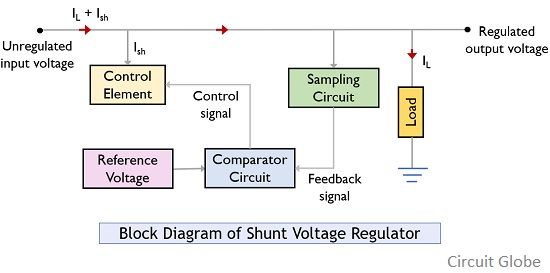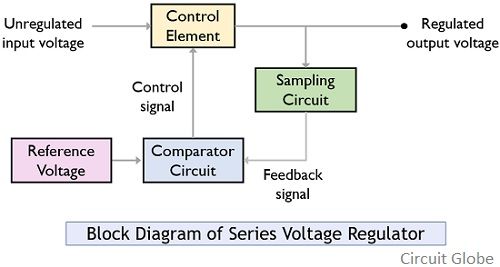Shunt and series voltage regulators are the two classifications of linear voltage regulators. The crucial difference between shunt and series voltage regulator is that in the shunt voltage regulator, the control element is in parallel connection with the load. On the contrary, in the series voltage regulator, the control element is serially connected to the load.
Both the voltage regulator circuits have their principle of operation thus have their own advantages and disadvantages which we will discuss in this article.
What is a Voltage Regulator?
A voltage regulator is a device that is used to maintain the output voltage at a constant value despite the variation in load current or input voltage. Its presence in electrical and electronic circuits is necessary as it tries to sustain the dc output voltage within a specified range irrespective of the variation in input voltage or load current.
Basically, an unregulated dc supply voltage is converted into regulated dc output voltage where the output voltage does not show significant variation. It is to be noted here that the control element is the major component of the circuit and its placement is different in the two types of regulator circuits.
Content: Shunt Vs Series Voltage Regulator
Comparison Chart
| Basis for Comparison | Shunt Voltage Regulator | Series Voltage Regulator |
|---|---|---|
| Connection orientation | The control element is parallelly connection with the load. | There exists a serial connection between the control element and the load. |
| Voltage Regulation | Poor | Good |
| Circuit design | Simple | Quite complex |
| Type of control element | Low current, high voltage component. | High current, low voltage component. |
| Current through the control element | Only a small amount of current flows through control element. | The complete load current passes through the control element. |
| Preferred for | Fixed voltage operations as it does not suit varying load conditions. | Shows suitability towards both fixed and variable voltage operations. |
| Compensation in change in output voltage | By varying the current through the control element. | By adjusting the voltage across the control element. |
| Efficiency dependency | On load current | On output voltage |
| Example | Zener shunt regulator | Series feedback regulator |
Definition of Shunt Voltage Regulator
The figure below shows the shunt voltage regulator:
It is clear from the above figure that the control element is parallelly connected to the load. Thus, it is called so.
Here the unregulated input voltage provides the load current. However, a part of the current flows through the control element present in the branch parallel to the load. This helps to maintain the invariable voltage at the load. Whenever the load voltage of the circuit varies then through the sampling circuit feedback signal is provided to the comparator. The comparator unit further makes a comparison between the feedback signal and the applied input.
The difference generated corresponds to the amount of current needed to be flowed through the control element to have constant load voltage.
Definition of Series Voltage Regulator
The below-given figure represents a series voltage regulator:
Here the control element is serially connected with the load. Hence is given the name series voltage regulator.
In the series voltage regulator, the control element is responsible for controlling the amount of input voltage that reaches the output. Thus, it is an intermediary element between the supplied unregulated input voltage and the output voltage. Like shunt regulators, here also a part of the output is fed back to the comparator through a sampling circuit where reference input and the feedback signal are compared.
So, on the basis of output generated from the comparator, a control signal is generated and it is further provided to the control element on the basis of which the load voltage is regulated.
Key Differences Between Shunt and Series Voltage Regulator
- The key factor of difference between shunt and series regulator is that the crucial element of the circuit i.e., the control element is present in parallel connection with the load. While the control element is present in serial connection with the load in the series regulator.
- In the shunt connection of the control element out of the overall current, only a fraction of current flows through it to keep the dc output constant. However, in series connection, the overall load current is allowed to pass through the load.
- The regulation offered by the series voltage regulation is comparatively better than the shunt voltage regulator.
- To maintain the constant value of the voltage at the load, the current through the control element is varied in the shunt regulator. While voltage across the control element is changed in case there exists a need for compensating the output voltage.
- The efficiency of the shunt voltage regulator depends on load current, thus, is not suitable for varying load conditions. However, the efficiency of the series voltage regulator relies on the output voltage.
- A shunt voltage regulator offers simplicity in designing as compared to a series voltage regulator.
- The shunt voltage regulators only suit fixed voltage operations. As against, the series voltage regulator shows suitability towards both fixed and variable voltage operations.
- In shunt configuration, the control element is a low current, high voltage rating component as some part of the load current is diverted. However, in a series configuration, the control element is low voltage, high current rating component as overall current passes through the control element.
Conclusion
Thus, the above discussion concludes that both shunt and series voltage regulators are used to regulate the voltage. However, the presence of a control element in the respective circuits leads to cause variation in the way the circuits operate.


